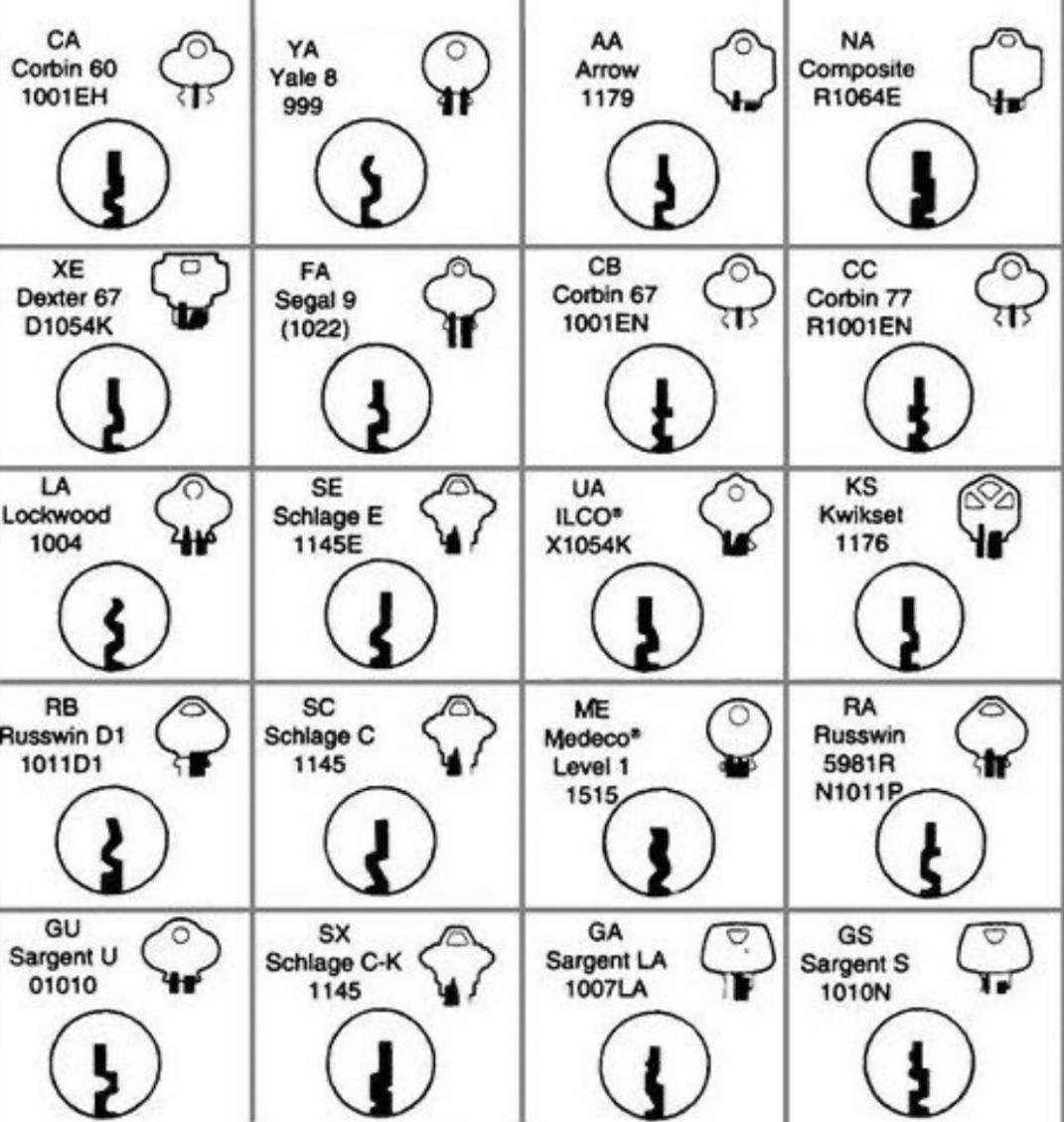Keys play a crucial role in our daily security—securing homes, offices, cars, and safes. But keeping tabs on all these keys can be a real headache. Ever picked up a key with no markings and scratched your head wondering what it opens? That’s where a key identification chart comes to the rescue. This useful tool often overlooked, helps you figure out different key types based on how they look, their structure, and what they’re used for.
Are you a locksmith someone who manages properties, runs a facility, or just trying to sort out your house keys? This guide will show you how to identify a key, get to know various key types, and use a key chart to keep things organized and stress-free.

What Is a Key Identification Chart?
A key identification chart is a visual reference that categorizes and displays different types of keys based on several physical characteristics. These charts are typically used by locksmiths, hardware store employees, and security personnel to match unknown keys with known blanks or to identify keys for duplication. However, homeowners, office managers, and renters can also benefit from them, especially when managing multiple keys for different purposes.
These characteristics include:
- Key head shape and brand marks
- Key blade length and width
- Cut patterns or bitting
- Grooves and ridges (keyway design)
- Material and finish
| Key Type | Visual Features | Common Uses | Special Notes |
| Household (KW1, SC1) | Flat, rectangular blade, jagged cuts | Home doors, office doors | KW1 = Kwikset; SC1 = Schlage |
| Car Key (Traditional) | Slim blade, unique grooves | Vehicles (pre-2010 models) | May have chip (transponder) inside |
| Car Key (Smart/Fob) | No blade, wireless remote | Modern vehicles | Push-to-start ignition systems |
| Padlock Key | Small, simple cuts | Padlocks, lockers | Often interchangeable |
| Tubular Key | Round, tube-like with small notches | Vending machines, bike locks | Very secure; harder to duplicate |
| Dimple Key | Flat blade with dimple-like holes | High-security locks | Precision-required for copying |
A key chart provides a side-by-side comparison of key blanks from various brands such as Schlage, Kwikset, Yale, Master Lock, Ilco, and more—making it easier to match keys to their corresponding locks.
Step-by-Step Breakdown to Identify a Key
Accurately identifying an unknown key requires careful observation and an understanding of its physical characteristics. Whether you’re managing keys for residential, commercial, or personal use, following a structured process ensures you can determine the key type, brand, and intended lock with confidence. Here’s a detailed process that anyone can follow—even without specialized tools:
1. Examine the Key Head
The key head is the large, often plastic or metal part that you hold. Many manufacturers imprint brand names, codes, or serial numbers here. These marks can help narrow down the key manufacturer and the keyway.
Example: A key head stamped with “KW1” is typically a Kwikset house key.
2. Look at the Blade Shape and Size
Each key type has a unique blade width, length, and profile. Car keys are often longer and thicker, while cabinet keys or furniture keys may be slim and short. Compare this to a key size chart to find a match.
3. Inspect the Grooves and Notches
The side grooves, or milling, determine how the key fits into a lock. These grooves are critical for matching the keyway, which is the internal path inside a lock. The notches or cuts (bitting) on the top or bottom of the key blade are what manipulate the lock’s pins.
4. Note Any Unique Features
Does your key have a round head? Is it flat, dimpled, or tubular? These features can indicate if it’s a tubular key, dimple key, or even a transponder key for vehicles.
5. Use a Key Identification Chart for Comparison
Once you’ve gathered this visual information, compare your key to a key identification chart. Many charts are sorted by brand, profile number, or keyway, and include images for direct comparison.
Common Types of Keys and How to Spot Them
Learning how to identify a key is easier when you’re familiar with the most common types. Here’s a detailed look:
| Key Type | Visual Traits | Common Uses |
| Household | Flat blade, single or double cuts | Home doors, garages, gates |
| Padlock | Small, basic cut pattern | Lockers, sheds, toolboxes |
| Car Keys | Long blade, chip or fob features | Vehicles (older and modern models) |
| Tubular | Circular, hollow shaft | Vending machines, ATMs, bike locks |
| Dimple | Small round dimples on both sides | High-security doors, safes |
| Skeleton | Long, antique with a simple bit | Vintage furniture, old doors |
1. Household Keys
Household keys are among the most commonly used key types and are typically designed for entry doors, interior doors, and garage locks in residential settings. They often follow standard profiles such as Kwikset (KW1) or Schlage (SC1) and they are recognized by their flat, single-sided blades with 5 to 6 cuts. Different types of locks from door locks to cupboard locks and safe locks require specific key designs and cuts.
2. Padlock Keys
Padlock keys are typically smaller and simpler in design compared to household keys. They are often used for lockers, gates, storage units, and toolboxes. Most padlock keys are flat with a unique cut pattern, and they may come in single or double-sided forms depending on the lock type.
3. Car Keys
Car keys come in various forms depending on the vehicle’s make, model, and year. Traditional metal keys are still used in older models, while modern vehicles often use transponder keys, laser-cut keys, or key fobs with electronic access. Modern car keys often include a chip or even a full remote system. If you lose a car key or key fob, you might wonder — can locksmiths make car keys yes they can. Below you can see modern car keys can be categorized into:
- Traditional metal car keys
- Transponder keys (with embedded chips)
- Laser-cut or sidewinder keys
- Key fobs and smart keys
4. Tubular Keys
Tubular keys stand out with their distinctive round, hollow design. You’ll often find them used in vending machines, ATMs, bike locks, and some specialized cabinets. Instead of edge cuts like traditional keys, they have notches arranged in a circle around the shaft, making them more secure and harder to pick. To identify a tubular key, look at its diameter, the number of notches, and how those cuts are aligned—each detail helps match it to the right lock.
5. Dimple Keys
Dimple keys are easy to recognize by the small, round indentations—called dimples—on both sides of the blade. These keys are used in high-security locks for homes, offices, and safes. Unlike traditional keys that use edge cuts, dimple keys rely on precise dimples that align with pins inside the lock.
6. Skeleton Keys
Skeleton keys are traditional keys designed to operate multiple locks within the same system, typically warded locks. They have a distinctive, elongated shape with a simple, often rounded bit at the end. Commonly found in antique furniture, old doors, and vintage cabinets, skeleton keys are valued for their historical charm and simplicity.
Why You Should Use a Key Identification Chart
With so many different types of keys in our daily lives—house keys, office keys, padlock keys, car keys—it’s easy to lose track of which key goes where. That’s where a key reference guide becomes incredibly useful. This simple yet beneficial tool helps you quickly recognize and categorize keys based on their shape, cuts, and brand markings. There are many benefits to using a key identification chart, including:
- Quick Matching: Instantly match unknown keys to known brands and blanks.
- Organization: Great for landlords, office managers, and maintenance workers who deal with large key rings daily.
- Security Awareness: Helps identify lost keys or verify if a key has been duplicated.
- Efficient Duplication: Speeds up the process of cutting or replacing a key at hardware stores or locksmith shops.
- Prevent Misuse: Avoid using the wrong key on high-value locks, reducing wear or potential damage.
Digital Tools and Apps for Key Identification
Today’s technology allows you to take key identification even further. Several apps and websites now offer digital key matching and visual key scanning, helping users identify a key with just a photo. These tools are helpful not only for locksmiths but also for real estate professionals and facilities managers who need quick access to key information on the go.
| Tool/App | Function |
| Keyscan Mobile | Snap a photo to match key types and brands |
| Ilco Key Web Reference | Huge online library of key blanks and codes |
| SmartLocksmith Tools | For managing complex master key systems |
How to Create Your Key Identification System
If you manage multiple keys regularly, having a structured key identification system is essential for maintaining organization and security. Rather than relying on memory or unlabeled keyrings, a personalized key reference method allows you to document, categorize, and store each key with accuracy. If you manage a lot of keys at home or work, setting up your identification chart is smart. Here’s how:
- Group Your Keys: Separate by type—home, office, garage, padlock, storage, etc.
- Photograph Each Key: Take clear, flat images showing both the head and the blade.
- Label Clearly: Add notes like “front door,” “mailbox,” or “filing cabinet.”
- Store Digitally or in Print: Use spreadsheets, apps, or print a binder to keep things accessible.
- Color Code or Use Key Tags: To make retrieval even faster.
If you’ve lost your original key, don’t panic. Skilled locksmiths can often make a key without the original.
Final Thoughts
Although a key identification chart may appear to be a basic tool, it serves an important function in maintaining organization and enhancing security. For locksmiths, property managers, or anyone responsible for handling multiple keys, understanding how to properly identify and categorize keys can significantly reduce time spent searching, prevent misplacements, and improve overall efficiency. Implementing a reliable identification method not only simplifies day-to-day tasks but also contributes to a more secure and well-managed environment.






